Dear Sir,
Your recent article about reactor communities struggling with high level radioactive fuel rods is comprehensive in regard to how much there is and the overwhelming desire of communities to make this waste go away.
What is missing is any thought of the people and communities who would be on the receiving end and how they would be affected by such a move.This includes all of the major cities along any proposed transportation route that high level radioactive waste would have to pass through either by road or rail.
How democratic is it to work to force this horrendous burden on people who don’t want it and have never received any benefit from it – unlike the communities where the waste is located?
There is also the matter of the Northern Shoshone, a tribe that lives in the high dessert of Nevada and has never signed a treaty with the United States government. They regard Yucca Mountain as sacred and have vowed to prevent it from being desecrated by being turned into a high level radioactive waste dump that is toxic for 240 thousand years.
Yucca Mountain is again pushed to the forefront, mainly because it was originally selected over the objections of the State of Nevada in what was called “The Screw Nevada Bill.” It is probably one of the most studied properties on the planet. The scientific consensus is that it is not good for long term deep geological storage. It is not dry and there are earthquake tremors one of which destroyed a small temporary office building on site on some years ago.
Most of the previous work that was done there was discarded when the site was closed down. Right now what was supposed to be the depository is an empty tunnel that curves around the top of a plateau in the high dessert of Nevada. When I visited several years ago it was cold and damp with water running down the walls in some sections. The side tunnels that were to house the waste have not been drilled. The enormous and enormously expensive tunnel drill that is specific to this site has been neglected for many years. At one point there was talk of selling it for scrap. If available, can it even be made to work again?
There is no good solution to the problem of nuclear waste. Few people seem to realize that a Yucca Mountain nuclear dump would hold only a small fraction of the waste that is currently at reactor sites. Should a national radioactive dump open, it will not be big enough to hold all of used fuel rods from reactors all over the country. The Nuclear Regulatory Commission has a protocol for determining the order of shipment. Like everything else in the nuclear industry it is subject to political pressure. Can you imagine the fight as reactor communities across the country struggle to be first on the list?
What makes the most sense is to stop producing more waste since we have no place to put what has already been created. What we have now is actually the safest, cheapest, most effective solution to this thorny problem, that is, dry cask storage on site in communities that reaped the benefits of hosting reactors in their community for so many years. Ask yourself how ethical it is for the used fuel rods from Indian Point to be shipped to another neighborhood, probably an impoverished one, for other citizens to deal with. Ask yourself if these people are willingly accepting your garbage and if there has been adequate consent based decision making.
What is needed is a legislated Citizens Oversight Board that represents all stakeholders and is not caught up in local politics. Legislated so that it is protected from the whims of local supervisors and mayors and can continue through the years to keep the public informed as long as the waste is on site, however long that may be.
Sincerely,
Marilyn Elie
Indian Point Safe Energy Coalition
A tour of the decommissioned Yankee Connecticut Power Plant in Haddam Neck Connecticut Aug. 21, 2019. Frank Becerra Jr. , fbecerra@lohud.com
—
About 1,000 spent fuel assemblies remain locked away in 43 cement and steel casks, each weighing 126 tons, on a concrete pad the size of a hockey rink guarded around the clock by armed security teams
The owners of shuttered nuclear power plants, exhausted by a decades-long political stalemate, are pressing Congress to find a permanent home for tons of nuclear waste stranded at their sites across the U.S.
Leading the charge is the Yankee Atomic Electric Company, a utility that ran nuclear power plants that generated electricity for ratepayers in Connecticut, Massachusetts and Maine until they shut down in the 1990s.
Today, the company’s sole function is as a storage facility for spent nuclear fuel in three states, their payroll covered by $30 million in federal tax dollars every year.
Yankee’s president and CEO, Wayne Norton, finds himself in the unusual position of begging the federal government to put him out of a job.
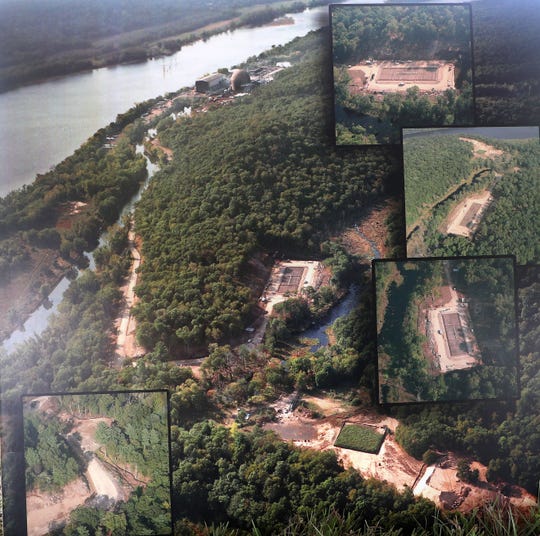
“The Yankee Companies are obviously long past frustrated with the federal government’s failure to meet its statutory contractual obligation to remove the spent fuel and high-level waste and essentially results in indefinite storage on site,” Norton told a gathering at the Connecticut Yankee plant in Haddam Neck last month. “The only reason that we remain in business is to safely and securely store this material until the government performs.”
Norton was standing in the middle of a picturesque, 525-acre site along the Connecticut River, a few hundred feet from where Connecticut Yankee’s single-unit reactor generated billions of megawatt hours of electricity for nearly 30 years. The plant shut down in 1996 and was decommissioned ten years later.
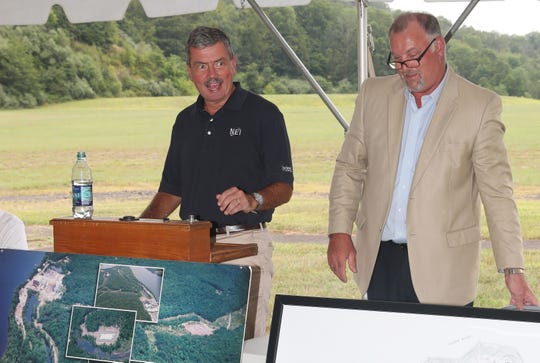
Today, the reactor site is a mound of grass and dirt. The reactor was demolished, its concrete and steel parts carted off to storage sites for low-level radioactive waste in Utah, Tennessee and South Carolina. In all, some 220 million pounds of low-level radiological waste and 400 million pounds of debris and material were hauled away.
But more than 1,000 spent fuel assemblies remain locked away in 40 cement and steel casks, each weighing 126 tons, on a concrete pad the size of a hockey rink guarded around the clock by an armed security team. It will remain there until the federal government fulfills a promise to open a repository for the nation’s spent fuel.
The Yucca Mountain debate
The USA Today Network got a rare peek behind the gates of Connecticut Yankee at a pivotal moment in the on-again, off-again debate over what to do with 80,000 metric tons of nuclear waste stranded at sites across the U.S.
Central to the debate is the future of Yucca Mountain, the site of an underground repository in the Nevada desert that, after decades of study that cost $15 billion, was selected by President George W. Bush in 2002 as the permanent site for the nation’s nuclear waste.
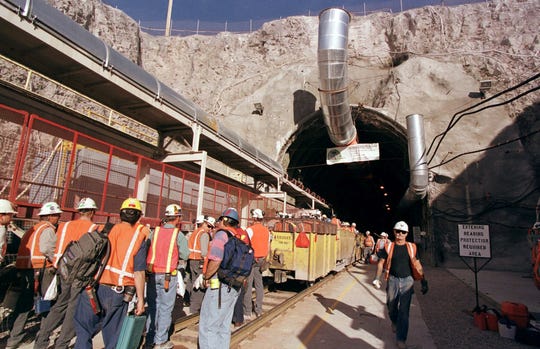
Efforts to wrap up the Nuclear Regulatory Commission’s scientific evaluation of the Yucca Mountain site were short-circuited in 2010 when the Obama Administration pulled back the licensing application for Yucca Mountain pending before the NRC.
But earlier this year, the Trump Administration included $120 million in its budget to reopen the process to decide whether Yucca Mountain should receive a federal license.
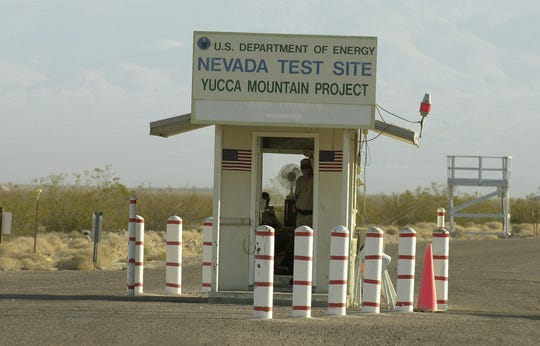
Members of Congress in communities that are home to stranded fuel have gotten behind the effort. Among them is Rep. Joe Courtney, a Connecticut Democrat whose district includes Connecticut Yankee.
“This is a poster child of the incongruity of this whole situation,” Courtney said, standing under a tent a few hundred feet from where the plant’s reactor once stood. “It costs too much money. It costs too much wasted effort. It deprives people of access to just an incredible part of the state of Connecticut in terms of its natural beauty, its archaeological history…The local community would love to see the day come when this material is gone, and it can be opened up for people to enjoy.”
Courtney and others are hopeful the growing number of towns across the U.S. stuck with stranded fuel will lend urgency to efforts to resolve the political logjam in Congress.
Some 20 reactors at 15 nuclear power plants across the U.S. have plans to shut down or are in the process of being decommissioned.
Among them are the Indian Point nuclear power plant in Buchanan, which is slated to shut down in 2021, and Oyster Creek in New Jersey, which shut down in the fall of 2018.
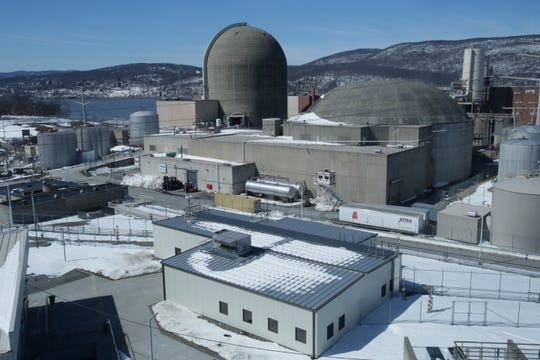
At a June hearing in Washington, senators debated resolving the logjam by including funding for two interim repositories, one in Texas, the other in New Mexico, which would house spent fuel until a permanent repository was approved.
“Do we continue to delay in the face of stalemate over Yucca or do we try to find another path forward for used fuel storage, especially for communities that are maintaining sites with only used fuel casks left on hand with the rest of the plant decommissioned,” said Alaska Sen. Lisa Murkowski, a Republican.
Rep. John Shimkus, an Illinois Republican and the leading House sponsor of efforts to open Yucca Mountain, has questioned whether interim facilities are a long-term solution.
“Shortcuts lead to dead ends and I’m concerned that the proposed measure that focused solely on interim storage, without integrating it into a permanent system for disposal, may sound good and expedient, but they will not work,” Shimkus said at House hearing in June.
Nevada against Yucca
The Nuclear Energy Institute, which represents the owners of nuclear power plants, agrees and says the Yucca Mountain proposal should not be abandoned solely on political grounds.
“For the sake of communities holding stranded used fuel wishing to redevelop their sites we must move forward and allow Nevada’s concerns to be heard by NRC’s independent administrative judges,” said Maria Korsnick, the president of NEI. “This will allow a licensing decision to be determined based on its scientific merits rather than politics.”
She said taxpayers are paying nearly $2.2 million per day to nuclear power companies to store spent fuel.
NEI is hoping the Senate will take the first step by including funding to restart the Yucca licensing process in the Department of Energy’s budget, when lawmakers return from a summer recess.
Nevada officials remain steadfast in their opposition. They’re bothered by a provision in pending legislation that does not require Nevada’s consent before spent fuel is sent there.
The state has vowed to challenge any efforts to reopen the Yucca Mountain process.
“Yucca Mountain would have to survive Nevada’s 218 admitted contentions and 30 new contentions, if licensing restarts,” Robert Halstead, who heads Nevada’s Agency for Nuclear Projects, told Congress at June hearing. “It would likely be 20 years or more, if ever, before any spent fuel could be received at Yucca Mountain.”
Nevada Sen. Catherine Cortez Masto, a Democrat, urged fellow senators to research alternative methods for storing nuclear fuel, and abandon Yucca Mountain.
“Department of Energy studies have already shown that walking away from Yucca Mountain and starting over with a new repository could save billions of dollars over the life of the facility,” Cortez Masto said in June. “We’ve had a stalemate over the last 32 years and we’ve offered the opportunity to come in and work with us and find a solution. I think you have that today. But unfortunately what I’ve seen from the industry is the same old playbook and not being willing to even admit there’s an opportunity to move forward.”
By Thomas C. Zambito
Source: https://webcache.googleusercontent.com/search?q=cache:aVdHpWAomcsJ:https://www.lohud.com/story/news/2019/09/03/yankee-atomic-electric-company-wants-yucca-mountain-site-explored/2020561001/+&cd=1&hl=en&ct=clnk&gl=us





